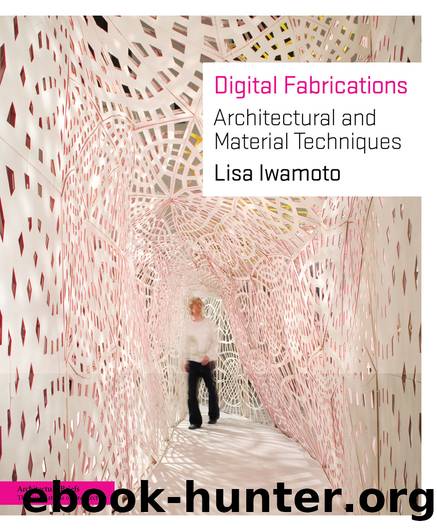Digital Fabrications by Lisa Iwamoto

Author:Lisa Iwamoto
Language: eng
Format: epub
Publisher: Princeton Architectural Press
Published: 2012-10-22T16:00:00+00:00
Diagram of Weaire-Phelan structure.
Courtesy: Nick Karklins
Chris Bosse/PTW Architects,
Watercube, 2008. Photo: Chris Bosse
Digital Origami and C_Wall both transform sheet material into structural building blocks. Both laser-cut and engrave and fold paper to make stackable modules. The designs differ significantly, however, in conception and result. As the designer, for PTW Architects, of the National Aquatics Center for the 2008 Olympics in Beijing, Bosse takes efficiencies employed in the structural envelope of the building to limit the number of cells while maximizing visual difference. Also known as the Watercube, the design employs a cellular organization based on foam, or the Weaire-Phelan structure, reputedly the most efficient cellular partitioning arrangement. It is composed of two types of irregular polyhedra—six tetrakaidecahedra (fourteen-sided) and two dodecahedra (twelve-sided)—that nest together to form a larger interlocking unit. Yet whereas the Watercube shears a large block of packed cells to arrive at the final interior and exterior surfaces, Digital Origami allows its thirty-five hundred recycled cardboard units to aggregate organically. The simplicity of the project’s construction method is belied by its visual complexity. The bottom-up structural logic fosters on-site design flexibility. Cells are left out at times for porosity, the outside fringes of the installation suggest possible future growth, and the design can be infinitely reconfigured to respond to different site conditions and constraints.
The cellular units of Andrew Kudless’s C_Wall, by contrast, are designed to fill a predetermined volume: one wythe thick. The Voronoi cells are generated using a computer script that uses points projected on the faceted surfaces of the form. Unlike the regularized eight modules of Digital Origami, each cell shape of C_Wall is unique, configured for one specific arrangement: the modular difference gives integrity to the whole. Though intricate and diverse, the units are subsumed into the larger figure of the piece. It is at once organic and constructed.
Download
This site does not store any files on its server. We only index and link to content provided by other sites. Please contact the content providers to delete copyright contents if any and email us, we'll remove relevant links or contents immediately.
| Automotive | Engineering |
| Transportation |
Whiskies Galore by Ian Buxton(41530)
Introduction to Aircraft Design (Cambridge Aerospace Series) by John P. Fielding(32888)
Small Unmanned Fixed-wing Aircraft Design by Andrew J. Keane Andras Sobester James P. Scanlan & András Sóbester & James P. Scanlan(32573)
Craft Beer for the Homebrewer by Michael Agnew(17933)
Turbulence by E. J. Noyes(7700)
The Complete Stick Figure Physics Tutorials by Allen Sarah(7141)
Kaplan MCAT General Chemistry Review by Kaplan(6595)
The Thirst by Nesbo Jo(6437)
Bad Blood by John Carreyrou(6275)
Modelling of Convective Heat and Mass Transfer in Rotating Flows by Igor V. Shevchuk(6223)
Learning SQL by Alan Beaulieu(6035)
Weapons of Math Destruction by Cathy O'Neil(5829)
Man-made Catastrophes and Risk Information Concealment by Dmitry Chernov & Didier Sornette(5647)
Digital Minimalism by Cal Newport;(5389)
Life 3.0: Being Human in the Age of Artificial Intelligence by Tegmark Max(5184)
iGen by Jean M. Twenge(5161)
Secrets of Antigravity Propulsion: Tesla, UFOs, and Classified Aerospace Technology by Ph.D. Paul A. Laviolette(4992)
Design of Trajectory Optimization Approach for Space Maneuver Vehicle Skip Entry Problems by Runqi Chai & Al Savvaris & Antonios Tsourdos & Senchun Chai(4840)
Electronic Devices & Circuits by Jacob Millman & Christos C. Halkias(4748)
